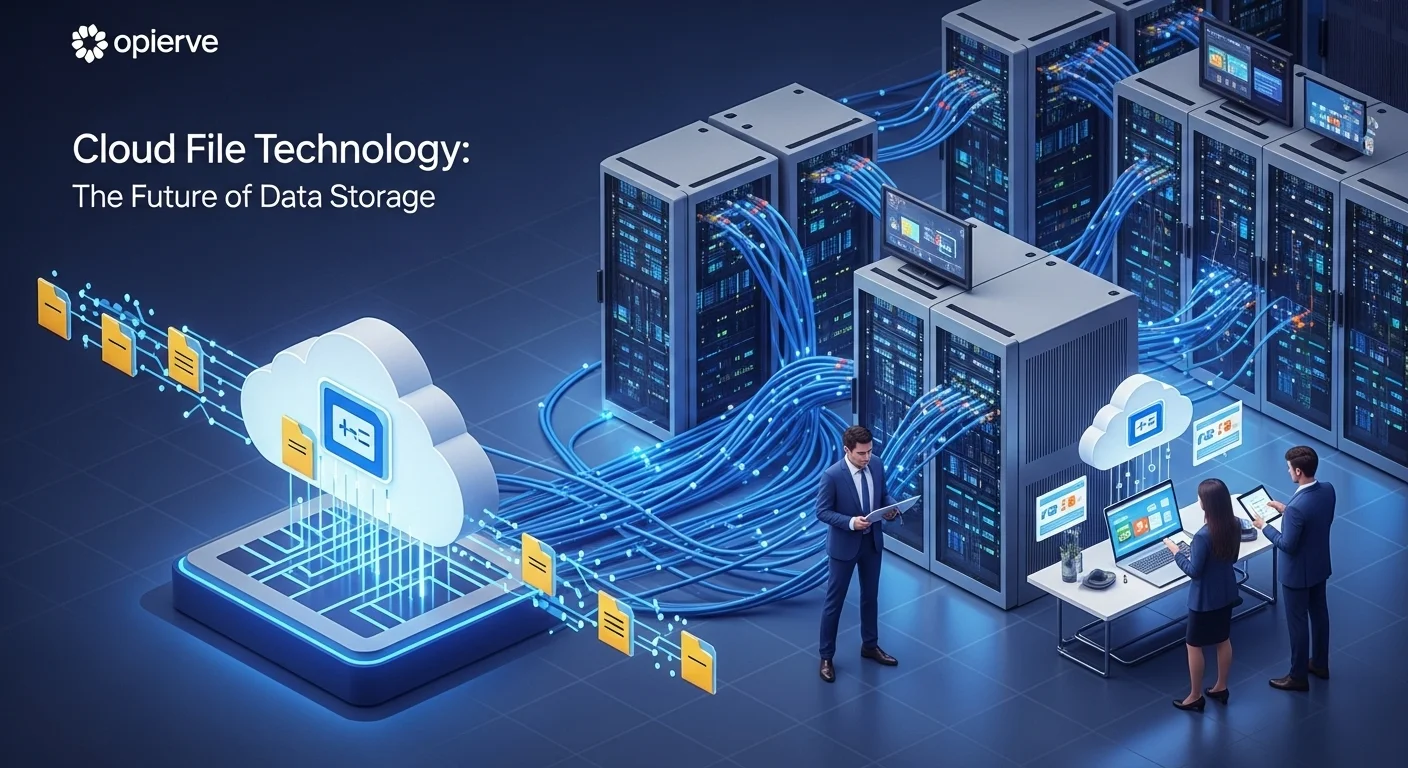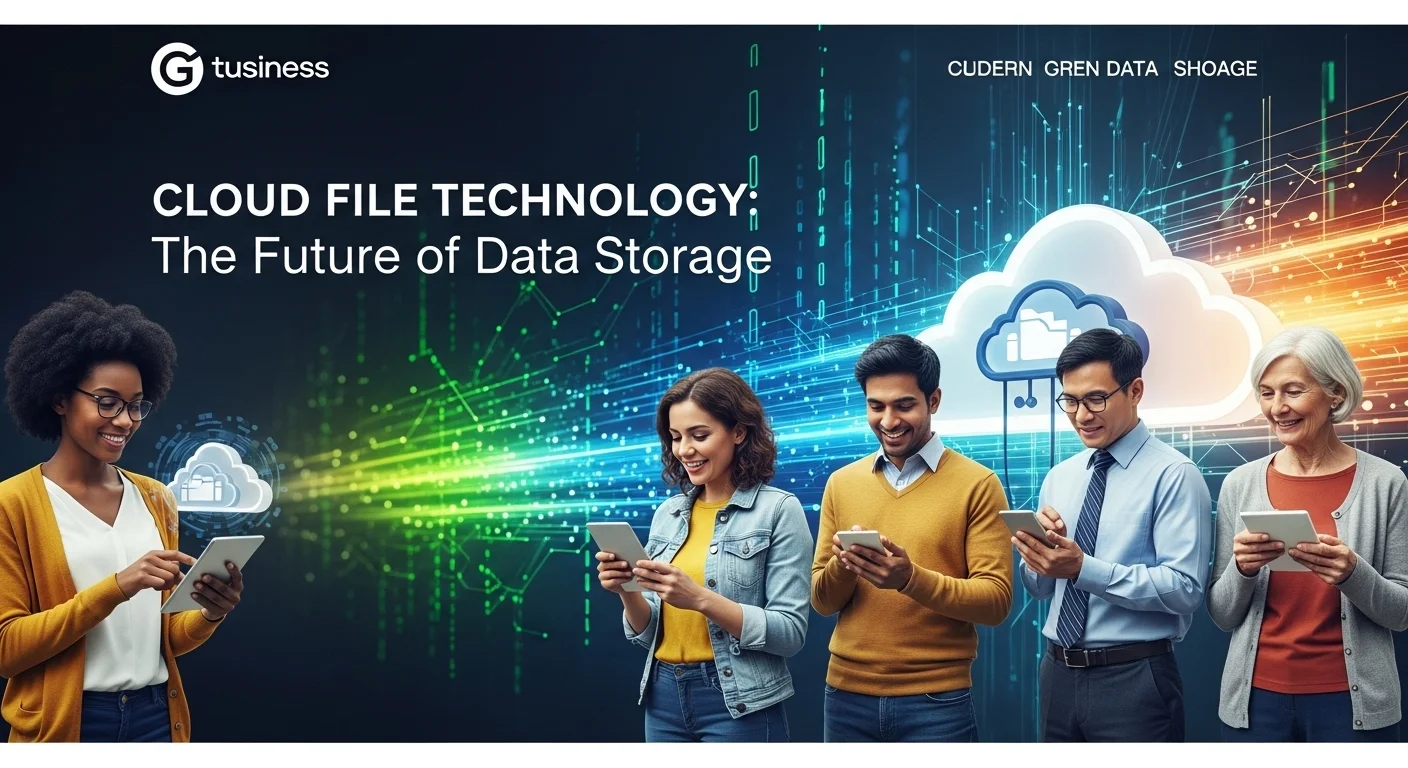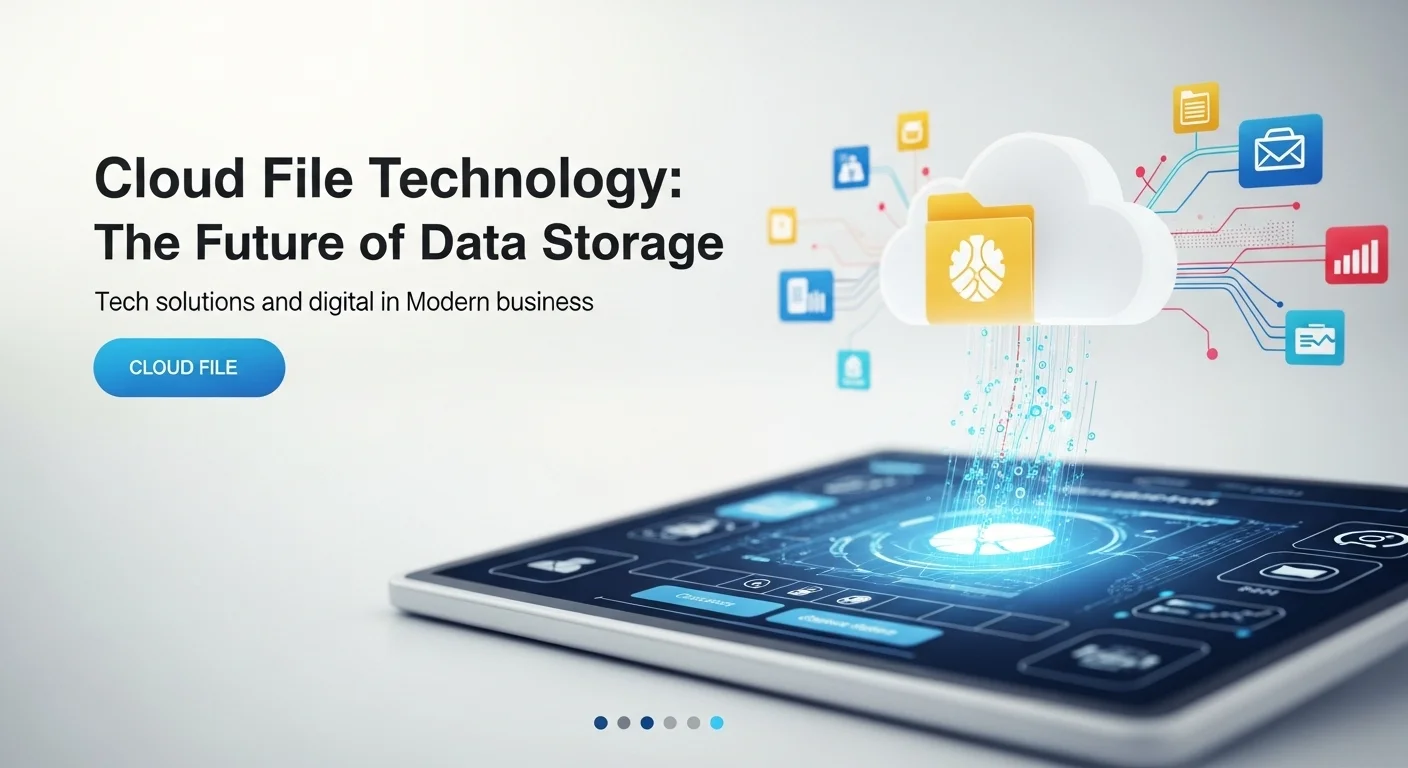Cloud File Explained: A Practical Guide to the Future of Data Storage

Executive Summary
I've spent years guiding businesses out of cramped, costly server rooms and into the flexibility of the cloud. It's a journey that's less about technology and more about freedom—the freedom to grow, collaborate, and innovate. This article is my personal guide to Cloud File technology. We'll skip the dense jargon and get straight to what matters: how it works, why it's a strategic move for your business, and how to choose the right solution. Whether you're an IT pro, a business leader, or just tech-curious, you'll walk away with a clear understanding of how to harness the power of cloud storage.
Table of Contents
Table of Contents
- What is a Cloud File and Why Does It Matter?
- The Technology Behind Cloud Files
- Why Cloud Files are a Game-Changer for Business
- The Rise of the Cloud-Based File Server
- A Guide to Cloud Service Models: IaaS, PaaS, and SaaS
- Comparing the Cloud Storage Giants
- Your Blueprint for Implementing a Cloud File Server
- Keeping Your Files Safe in the Cloud
- Pro Tips for Mastering Cloud Costs
- Advanced Security Strategies for Your Cloud Fortress
- Beyond Storage: Advanced Uses for Your Cloud Files
What is a Cloud File and Why Does It Matter?
In today's world, data is the engine of business. But the way we manage that data has been completely turned on its head. I remember the days of being called in to swap out failed hard drives on a local server at 2 AM. At the forefront of this massive change is Cloud File technology. So, what is a cloud file? Put simply, it’s any digital file—a document, a photo, a project plan—that lives on a network of powerful, remote servers instead of your computer's hard drive. This network is what we call 'the cloud'. This idea of online file storage in cloud computing isn't just a technical tweak; it's a fundamental shift that gives us incredible flexibility and power.
To really get why this matters, think about the old way. For years, companies were locked into physical storage. We had filing cabinets, then hulking on-premise servers and Network Attached Storage (NAS) boxes. These systems worked, but they were a headache. They were expensive to buy and maintain, a nightmare to upgrade, and chained your team to the office. Collaboration meant emailing attachments back and forth, creating a confusing mess of different versions. The cloud shattered those limitations. Cloud storage is a service where you rent storage space from a provider like Amazon or Google, paying as you go. It takes all the hardware headaches off your plate so you can focus on running your business.
The Technology Behind Cloud Files
When you upload a file to the cloud, it doesn't just go to one computer in a warehouse somewhere. It's much smarter than that. The technology uses what we call virtualization and distributed computing. Your file is often broken into pieces and copied across multiple servers, sometimes in different cities or countries. This duplication, or redundancy, is the secret sauce. It makes the cloud incredibly reliable. If one server goes down, your data is still safe and instantly available from another. This provides a level of disaster recovery that used to be insanely expensive for most businesses to build themselves.
There are three main ways the cloud handles your files, and understanding them helps you choose the right tool for the job:
- Object Storage: Think of this like a massive valet parking service for your data. Each file is an 'object' with your data, some descriptive metadata, and a unique ticket number. It’s perfect for storing huge amounts of unstructured data like photos, videos, and backups. Services like Amazon S3 and Google Cloud Storage are the titans in this space.
- File Storage: This is what most people are familiar with. It organizes data in folders and files, just like on your PC. It’s the backbone of a cloud based file server, giving you that familiar 'shared drive' experience, but with all the benefits of the cloud.
- Block Storage: Imagine your data stored as individual Lego bricks ('blocks') that can be assembled very quickly. This high-speed storage is used for demanding applications like large databases or enterprise systems that need lightning-fast data access.
Why Cloud Files are a Game-Changer for Business
Moving to the cloud isn't just an IT project; it's a strategic business move. The benefits are felt across the entire organization.
First, collaboration gets a massive boost. With files in the cloud, your team can access and edit documents from anywhere, on any device. I’ve seen this transform global teams, allowing them to work together in real-time as if they were in the same room. No more 'Final_v2_final_final.docx' confusion. Everyone works from one single, up-to-date version.
Second, you get incredible scalability and flexibility. An old-school server has a fixed amount of space. When it's full, you're in for a costly and slow upgrade process. With the cloud, your storage is virtually limitless. You can scale up for a big project and scale back down when it's done. This changes your spending from a huge upfront capital expense (CapEx) to a predictable monthly operating expense (OpEx), which is a lifeline for startups and growing businesses.
Third, your security and disaster recovery are often better than what you could build yourself. Top cloud providers pour billions into physical and digital security. Your data is encrypted as it travels over the internet and while it's stored on their servers. And if a disaster like a fire or flood hits your office, your data remains safe and sound in the cloud, ready for you to access. Business continues, uninterrupted.
The Rise of the Cloud-Based File Server
For many businesses, the file server is the heart of their daily operations. A cloud based file server delivers all the functionality of that trusted server but without any of the physical hardware. It’s a central, secure hub for all your company files, often accessible just like a traditional mapped network drive. This makes the switch to the cloud feel seamless for your team.
Using a cloud based file server removes the burden of server maintenance, patches, and hardware replacements from your IT team, freeing them up to work on more valuable projects. These servers also integrate beautifully with other cloud tools, from Microsoft 365 to advanced AI platforms, creating a powerful, connected ecosystem. The key is finding the best cloud file server for your specific needs—it's not a one-size-fits-all world, but about finding the perfect match for your company's workflow, security, and budget.

A Guide to Cloud Service Models: IaaS, PaaS, and SaaS
Okay, so you're sold on the 'why'. Now let's get into the 'how'. Choosing a cloud solution can feel like walking into a massive store with thousands of options. To simplify things, let's break down the three main service models. Think of it as choosing between renting the land to build your own house, renting a pre-built house you can decorate, or just checking into a fully furnished hotel.
- Infrastructure as a Service (IaaS): This is the 'rent the land' option. The provider gives you the raw computing ingredients—servers, storage (like Amazon S3 or Azure Blob Storage), and networking. You have the most control and flexibility to build a custom cloud based file server, but it also requires the most technical know-how to manage.
- Platform as a Service (PaaS): This is the 'pre-built house'. The provider manages the underlying infrastructure and gives you a platform and tools to build and run your own applications. It’s a middle ground that saves you from managing hardware but still gives you development power.
- Software as a Service (SaaS): This is the 'fully furnished hotel'. The provider handles everything—the hardware, the platform, and the software itself. You just log in and use it. Services like Dropbox Business, Box, and Microsoft OneDrive are classic examples. It's the easiest path for most businesses looking for straightforward online file storage in cloud computing.
Comparing the Cloud Storage Giants
The market is led by a few heavyweights, and picking the best cloud file server often comes down to your company's existing tools, needs, and budget. Here’s my breakdown from years of working with these platforms.
Comparison of Major Cloud Storage Providers
| Provider | Core Service | Key Strengths | Best For |
|---|---|---|---|
| Amazon Web Services (AWS) | Amazon S3, Amazon FSx | The original and most mature platform. Unmatched set of services, reliability, and fine-grained control. | Anyone, from startups to enterprises, especially if you're already in the AWS world or need deep customization for things like analytics and AI. |
| Google Cloud Platform (GCP) | Google Cloud Storage, Google Drive | Incredibly fast network, user-friendly, and a leader in big data and machine learning. | Companies that live in Google Workspace and prioritize high performance and cutting-edge data analytics. |
| Microsoft Azure | Azure Blob Storage, Azure Files | Flawless integration with the Microsoft world (Windows Server, Microsoft 365). Strong enterprise features and great for hybrid setups. | Businesses that are built on Microsoft products. The integration is seamless and powerful. |
| Dropbox Business | Dropbox | Famous for its simplicity and ease of use. File sync is rock-solid and it connects to thousands of other apps. | Creative teams and businesses that need dead-simple file sharing and collaboration without a big IT team. |
| Box | Box | Laser-focused on security, compliance, and automating workflows. Has all the certifications you can think of. | Large companies in regulated fields like healthcare or finance that need ironclad security and content management. |
Your Blueprint for Implementing a Cloud File Server
Moving to a cloud based file server is a big project, but with a solid plan, it can be a smooth process. Think of me as your guide for this journey.
Step 1: Know Thyself: The Needs Assessment
Before you even look at a vendor, look inward. Ask the tough questions:
- How much data do we have? And more importantly, how fast is it growing?
- How fast do we need it? Are we editing massive video files or just archiving Word documents? Performance needs vary wildly.
- Who needs access? Just internal staff? Partners and clients too? From the office or all over the world?
- How sensitive is our data? Do we have compliance rules like GDPR or HIPAA to follow? This is non-negotiable and will shape your security choices.
- What does it need to talk to? Does it need to connect to your sales, finance, or identity management software?
Step 2: Choosing Your Partner: Vendor Selection
With your checklist in hand, you can now start evaluating providers. Don't just read the marketing hype. Sign up for free trials, watch demos, and find case studies from your industry. And look closely at pricing—it's not just the cost per gigabyte. Watch out for data transfer (egress) fees, which can be a surprise. Getting this right is how you find the best of the many cloud file servers out there.
Step 3: The Big Move: Data Migration
Getting your existing data into the cloud is often the trickiest part. If you only have a little bit, you can transfer it over the internet. But for huge amounts of data, that would take forever. For these cases, providers offer physical devices like the AWS Snowball. They mail you a secure, rugged hard drive, you load your data on it, and ship it back. They then upload it directly. I often recommend a phased approach—move one department at a time to minimize disruption.
Step 4: Flipping the Switch: Configuration and Training
Once the data is there, you configure your system. Set up folders, create user groups, and define who can see and do what. A golden rule here is the 'principle of least privilege'—only give people access to what they absolutely need. Connect it to your other systems for a smooth workflow. And finally, the most important step: train your team. Show them how it works, what the new rules are, and how it will make their lives easier. Happy users are the key to a successful project.
Keeping Your Files Safe in the Cloud
While cloud providers build fortresses, you're still responsible for locking the doors to your own rooms. Security is a shared responsibility. Here are the essentials:
- Encrypt Everything: Make sure your data is scrambled both when it's being stored (at rest) and when it's traveling over the internet (in transit). The big players do this by default, but always double-check.
- Be a Bouncer: Use strong access controls. People should only have the keys to the files they need for their job. No more, no less.
- Use Multi-Factor Authentication (MFA): A password isn't enough anymore. Requiring a second form of verification (like a code on your phone) is one of the single most effective security measures you can take.
- Keep an Eye on Things: Use logging tools to track who is accessing what and when. Regularly review these logs for anything that looks suspicious.
By following this blueprint, you can confidently move to the cloud. Finding the best cloud file server is a strategic journey, but when done right, it builds a powerful foundation for your business's future.

Pro Tips for Mastering Cloud Costs
So, your cloud file system is up and running. Fantastic! But don't set it and forget it, especially when it comes to cost. Cloud bills can creep up on you if you're not paying attention. Think of it like electricity—you need a strategy to avoid waste.
- Use Smart Storage Tiers: Not all your data needs to be on the 'top shelf'. Some files you need instantly, while others are just kept for legal reasons. All major providers offer different storage tiers. 'Hot' storage for frequently used files is more expensive than 'Cold' or 'Archive' storage for data you rarely touch. I've helped companies save over 50% on their storage bills just by setting up automated rules that move files to cheaper tiers after they haven't been touched for 30 or 90 days.
- Watch Out for Egress Fees: This is the 'gotcha' for many new cloud users. Uploading data is usually free, but downloading it or moving it around (egress) costs money. Use your provider's cost tools to see where your data is going. If you share a lot of files publicly, using a Content Delivery Network (CDN) can often be cheaper for delivery than serving directly from your storage.
- Tag Everything for Accountability: In a big company, it’s easy to lose track of who is using what storage. Enforce a strict tagging policy. By labeling every storage resource with a project, department, or cost center, you can generate detailed reports that show exactly who is spending what. This creates accountability and helps everyone make smarter decisions.
Advanced Security Strategies for Your Cloud Fortress
The basics are essential, but to truly protect your data in your online file storage in cloud computing solution, you need to think like a security pro. It's about building layers of defense.
- Adopt a 'Zero-Trust' Mindset: The old idea of a safe 'internal network' and a dangerous 'outside world' is dead. The Zero-Trust model works on a simple principle: 'never trust, always verify.' It means that every single request to access a file is challenged for identity and authorization, even if it's coming from inside the company. It's like having a security guard at every door inside the building, not just at the front gate.
- Deploy Intelligent Threat Detection: The best cloud file servers now offer smart security services that use machine learning to spot weird behavior. Tools like Amazon GuardDuty or Azure Sentinel can analyze activity logs and alert you to potential threats in real-time, like someone trying to download your entire customer list at 3 AM from a new country.
- Prevent Data Leaks with DLP: Data Loss Prevention (DLP) tools are your digital guardrails. They can scan files for sensitive information like credit card numbers, social security numbers, or internal intellectual property. You can then set up rules to automatically block that file from being shared outside the company, protecting you from accidental or malicious leaks.
Beyond Storage: Advanced Uses for Your Cloud Files
Thinking of your cloud storage as just a digital filing cabinet is a huge missed opportunity. The reason you choose the best cloud file server is also for what it enables tomorrow. These platforms are built for innovation.
- Create a Data Lake for Analytics: Cloud object storage is the perfect foundation for a 'data lake'—a massive, central repository for all your business data, structured and unstructured. Once your data is in one place, like AWS S3, you can run powerful query tools directly on it to uncover business insights that were impossible to see when the data was scattered everywhere.
- Fuel Your AI and Machine Learning Ambitions: The current AI revolution runs on data—massive amounts of it. Cloud storage provides a scalable and affordable place to keep the huge datasets needed to train machine learning models. The AI and Machine Learning platforms from cloud providers are built to work directly with their storage, making it easy for data scientists to build, train, and deploy new models.
- Deliver Content Blazing Fast, Worldwide: If you serve customers globally with images, videos, or software, you need a Content Delivery Network (CDN). A CDN integrates with your cloud storage and caches copies of your files in data centers all over the world. When a user in Japan requests a file, they get it from a local server in Asia, not from your primary server in the US. The result is a dramatically faster, better experience for your users.
If you're ready to get into the nitty-gritty, the vendor documentation is an amazing resource. For instance, check out the comprehensive guide to Amazon S3 Storage Classes to see exactly how data tiering works.
Ultimately, managing your cloud file server is an ongoing journey of refinement. By mastering costs, layering your security, and exploring what's possible beyond simple storage, you can turn your cloud investment into a true competitive advantage. The key is to stay curious and always connect your technology strategy back to your business goals. Implementing a cloud based file server is just the first step on an exciting path.
Expert Reviews & Testimonials
Sarah Johnson, Business Owner ⭐⭐⭐
This was a good overview of Cloud File, but as a small business owner, I'd have loved a few more real-world examples for companies my size.
Mike Chen, IT Consultant ⭐⭐⭐⭐
A really solid article on Cloud File. It clarified a lot for me. A couple of the more technical concepts could be broken down even further, but overall it was very helpful.
Emma Davis, Tech Expert ⭐⭐⭐⭐⭐
Fantastic article! As a tech specialist, I found this guide on Cloud File to be incredibly thorough and clear. It's been a great help for my work, and I understood every part perfectly.



